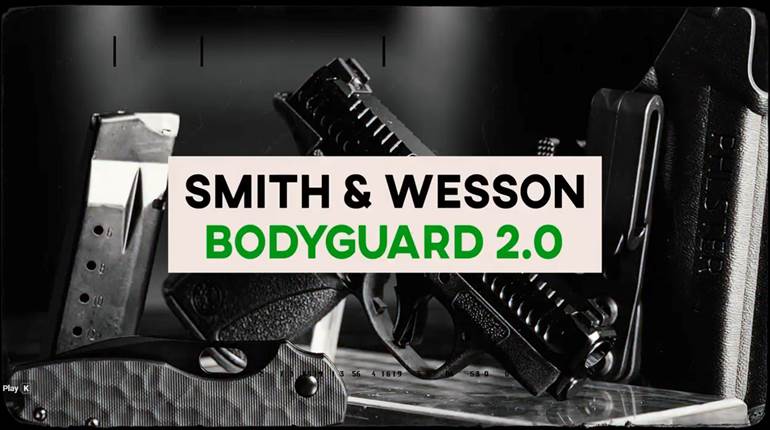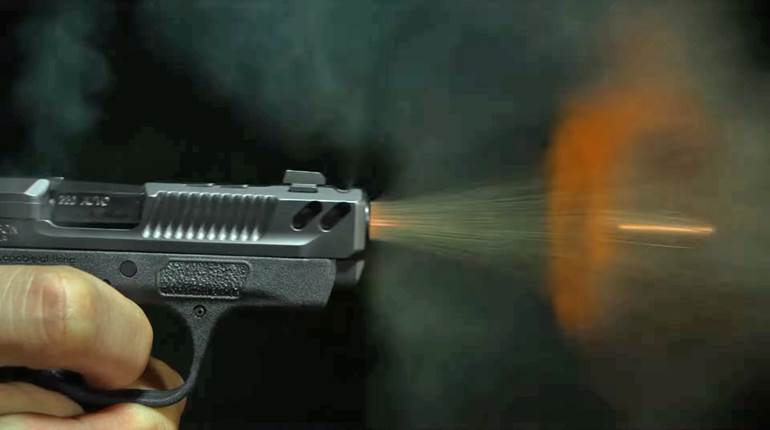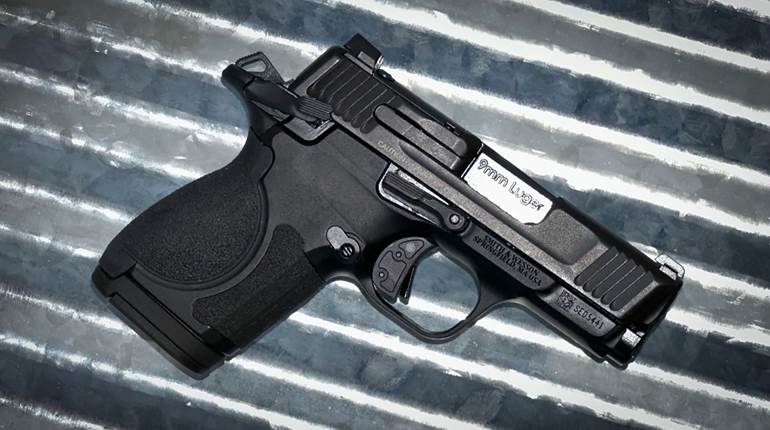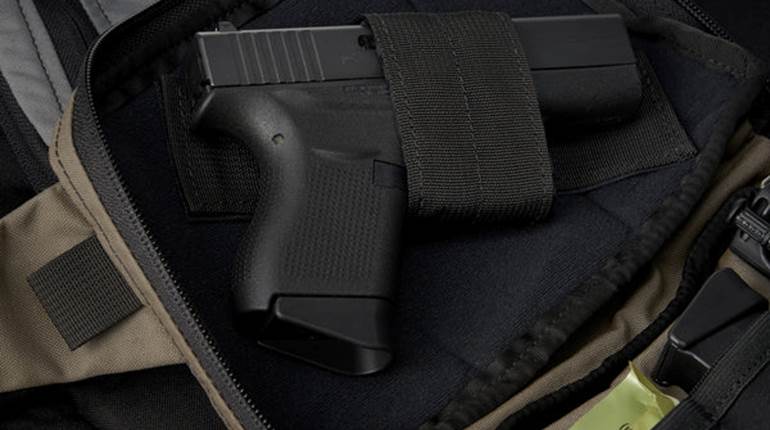
To be honest, my first range session with Smith & Wesson’s X-Frames was not all that pleasant. Even at an outdoor range, the roar of the guns was deafening and, despite wearing gloves, the recoil was bruising. I was glad for the opportunity to gain hands-on experience with a couple of the most powerful handguns on the market, but during my first practice with the S&W500 and 460XVR revolvers, I had concerns that the hunt of a lifetime—an opportunity for South African plains game—would also be the greatest challenge I would face as a hunter and shooter. Still, the guns possess an undeniable draw that hooked me from the start; their weight in the hand, the long rotation of the cylinder, the light and smooth single-action trigger pull, all culminating in an eruption of fire and thunder and recoil. When you hold an X-Frame, you know you’re holding a gun. And when you pull the trigger, and feel that power, it’s an undeniable rush.
The .500 S&W Mag.
Power is exactly what Smith & Wesson was chasing with its X-Frame line of revolvers. The company had gotten a taste when, in the film “Dirty Harry,” Clint Eastwood’s eponymous character stood brandishing a S&W Model 29 and boldly declared the .44 Mag. the “most powerful handgun in the world.” Though the statement may not have been factually correct, as the .454 Casull was already extant at the time of the film’s release, its spirit resonated with consumers and propelled Smith & Wesson, in both status and sales, to the top of the wheelgun market. Years later, when cartridges such as the .454 Casull and the .480 Ruger began usurping the .44 Mag.’s top position, Smith employees and engineers were eager to re-establish their claim.

The effort would be led by Smith & Wesson’s Herb Belin who, in 2002, set out to develop a new cartridge that, in his words, would be “unsurpassed and may be unsurpassable.” It was an audacious plan, and as Paul Pluff, director of marketing communication for S&W, confirmed, “It was all about bragging rights and ego.” But for all the bravado, there were also keen minds and clever solutions that would ensure the venture met with success.
Take the caliber selection, for example. Smith & Wesson’s goal was the most powerful handgun cartridge in the world. The company did not intend to compete with handguns firing rifle cartridges, where a large case could be necked down to achieve tremendous speed and power from a relatively small bullet. Rather, the goal was to create the most powerful cartridge using a traditional, straight-wall handgun case. And in choosing caliber, Smith did not build up to .500", it started there. Per the 1934 National Firearms Act, and its 1968 revisions, firearms with a bore greater than 1/2", or .500 caliber, are classified as destructive devices and regulated as such. So, as Pluff explained, “We knew that .500 was the largest caliber we could produce … that was the line, and we went right to the limit.”

Not only did Belin and his team go to the limit, they did so in record time. With the help of Peter Pi of Cor-Bon Ammunition, it took less than a year for Smith & Wesson to introduce both a revolutionary new cartridge—the .500 S&W Mag.—and, to fire it, the most powerful revolver in the world, the Model S&W500.
To evaluate the new cartridge and revolver, in early 2003 American Rifleman assigned then-Shooting Editor Scott E. Mayer the story. Looking first at the ammunition, Mayer reported on Cor-Bon’s three initial offerings for the new .500 S&W Mag. cartridge. They included a light, 275-gr. load clocked at 1561 f.p.s. and yielding 1,489 ft.-lbs. of energy—far greater than the .44 Mag., but not the most powerful available. The two heavier loads, 400- and 440-gr., were a different story. Both were chronographed at approximately 1650 f.p.s. which represents around 2,400 and 2,660 ft.-lbs., respectively—far and away the most powerful handgun loadings at the time.
Propelling such heavy bullets to those velocities generates substantial pressure and punishing recoil. So it was quickly recognized that simply expanding the chamber and barrel diameters on an existing platform would not have been a safe or viable option for shooting the new cartridges. Instead, Smith & Wesson developed an entirely new revolver. The X-Frame, and its initial .500 S&W Mag. model, possessed several attributes that made it not only suitable for the powerful loadings, but also practical for shooting. After all, what’s the point of having the most powerful handgun cartridge if no one can effectively shoot it?
To address the power of the cartridges, the Smith & Wesson team incorporated several features that would bolster the gun’s strength. First, and perhaps most obvious, is the X-Frame’s 2.3"-long cylinder, with a diameter of nearly 2". It is substantially larger than even Smith’s “Large” or N-frame wheelguns. Despite having such a sizable cylinder, the X-Frames hold only five rounds. The arrangement was devised because, first, a six-round cylinder for the .500 S&W Mag. cartridge would be impractically large. Also, the five-shot configuration allows the cylinder’s stop notches to be located between the chambers, at the cylinder’s thickest section—a change even from the .44 Mag. revolvers where the notches are located above each chamber. The cylinder’s design acknowledged the power of the .500, but it also gave the X-Frame platform room to grow, should longer or higher-pressure cartridges be introduced later.
Another bulwark against powerful recoil is the X-Frame’s ball detent lock. Integral to the gun’s frame, and engaging a corresponding cutout in the yoke, under recoil the ball is forced farther into the yoke, strengthening lockup when the forces are greatest. Finally, in order to make the hefty handgun practical and shootable, particular attention was paid to the grip. Rather than using the pre-existing N-frame grip, or even enlarging it, Smith instead chose the mid-size, ergonomic K-frame grip as a foundation. In this way, extra-large hands are not required to handle the extra-large gun. Also, overmolded Hogue monogrips were chosen in place of traditional stocks to provide extra purchase and cushioning for the shooter’s hand during firing.
The overall package, cartridge and gun combined, proved indeed to be the most powerful that the revolver world had to offer. It was also accurate, the average of Mayer’s 15, five-shot groups—using the three Cor-Bon loads and an unmagnified optic—was just larger than 2.5" at 50 yds. Maybe most importantly, the pairing was shootable. Indeed, Mayer coined the phrase “manageable magnum” to describe the S&W500, and it is that characteristic, combined with its serious stopping power, that helped the X-Frame endeavor transcend “bragging rights” and gain traction as an effective hunting handgun.
The .460 S&W Mag.
Flush with the successful development and launch of the most powerful production handgun, Belin and his team set their sights on yet another looming distinction—the fastest production handgun. At the time, Cor-Bon’s 265-gr. .454 Casull load probably held that title, with reported velocities in excess of 1700 f.p.s. Belin, again, would not be satisfied merely to outstrip his competitors, he wanted to set a near-unbeatable mark. The stated goal for the new project would be to propel a 200-gr., .45-cal. bullet to 2500 f.p.s. from an 83⁄8" barrel, while maintaining a high degree of accuracy.

Given the speed already achieved by the .454 Casull, and it’s SAAMI-specified maximum average pressure (MAP) rating of 65,000 p.s.i., it should be no surprise that that cartridge provided the starting point for what would become the .460 S&W Mag. Belin again enlisted the help of Cor-Bon, but also made inquiries with Hornady Mfg. What resulted was essentially a blind arms race between the two ammunition companies, with Belin sharing just enough information to keep the firms motivated.
Because the new cartridge was being developed in conjunction with a new X-Frame revolver, the ammunition makers were afforded a few mechanical advantages by Smith’s big wheelgun. First, the X-Frame was already a heavy-duty firearm, so chamber pressures nearing 60,000 p.s.i. were, if not desirable, at least considered manageable. Second, the X-Frame’s lengthy cylinder accommodated longer cases that could hold more propellant. In its final form, the .460 S&W Mag. possessed a 1.80"-long case, 0.417" longer than that of the Casull.
Though the X-Frame had its advantages, the stock S&W500 revolver did not seamlessly transition into a .460; nor did a longer case lead directly to a faster projectile. As the ammunition was developed and tested, some of the gun’s features, such as the frame-to-yoke ball detent lock, again proved their worth. Other characteristics, such as the S&W500’s metallurgy, were found wanting when pitted against the higher pressures of the .460 S&W Mag. Too, stabilizing a heavy bullet at high speeds in a relatively short barrel proved challenging. Still, solutions were found: A heat-treating process applied to the frame and
cylinder bolstered the metal’s strength; gain-twist rifling, from 1:100"-1:20", stabilized the bullets; and custom propellant mixtures were developed with burn rates ideal for maximizing the velocity of a 200-gr. bullet. In 2005, within six months of starting development, Hornady had achieved 2200 f.p.s. with the new cartridge, Cor-Bon had a load that managed 2300 f.p.s., and the 460XVR (Xtreme Velocity Revolver) became the fastest production handgun in the world.

Former Rifleman Managing Editor Aaron Carter evaluated the .460 revolver and ammunition (May 2009, p. 52) and addressed their performance by saying, “[The 460XVR and .460 S&W Mag. ammunition] produce a desirable blend of high energy and flat trajectory … but there’s another aspect that’s equally important: accuracy.” During his testing, Carter used five different .460 S&W Mag. loadings and fired 25, five-shot groups. His combined average group size at 50 yds. was just 1.45". Though Belin’s goal of 2500 f.p.s. was just missed, at least with the 83⁄8" barrel, Smith & Wesson again succeeded in not only pushing the boundaries of handgun and ammunition capabilities, but also in producing a firearm/ammunition combination with real utility, especially for handgun hunters.
X-Frames In The Field
Beyond their “fastest” and “most powerful” monikers, Smith & Wesson’s X-Frames are serious handguns for serious hunters. If one can come to grips with the report and recoil of the big guns, they are capable of superb accuracy and knock-down power, within reasonable range limits. I fired my first shots with the .460 and .500 S&W magnums in 2014, but by then the relatively young cartridges were already seasoned veterans of the world’s hunting fields. Beyond handling the marketing efforts for Smith & Wesson, Paul Pluff is also one of the most avid, and experienced, handgun hunters in the industry today. I spoke with him about the capabilities of the cartridges, and he made it clear that there really is no limit. “From boar and whitetail to Cape buffalo and elephant, these guns have taken on all of them, and gotten the job done.” Pluff explained that he sees the .460, with its flatter trajectory, as a great North American cartridge and the .500 as capable of really thumping brown bears and other dangerous game. He sees these guns as the ideal firearms for the guy who thinks bigger and faster is better, and who wants the tools to hunt just about any game in the world.

Over time, Smith & Wesson has made it easier for potential customers to find the right X-Frame to suit their needs. It catalogs models that come equipped with bipods or that can accommodate slings. There are also short-barrel “bear guns,” and models with longer tubes to really wring out a cartridge’s best performance. Many models boast compensators to better direct expelled gases and control recoil, and some come standard with interchangeable devices to match the shooter’s preference. Though most variants are equipped with adjustable iron sights, the guns also come with, or easily accommodate, accessory rails for mounting range-extending optical sights. Shooters should be aware, though, that optics and mounts need to be tough in order to stand up to the magnum recoil. The rings and rails offered by Warne Scope Mounts, for example, are a safe bet for use with X-Frames, and handgun scopes from reputable makers are generally up to the task.
My own field experience involved a trip to South Africa where the X-Frames—S&W500s and 460XVRs topped with unmagnified EOTech XPS2 holographic sights—in the hands of several hunters, were pit against the various plains game inhabiting the bushveld just south of the Limpopo River. In preparation for the trip, I learned a few valuable lessons about shooting the big wheelguns. As alluded to in the opening, during my first range session I got beat up by the recoil a bit and accomplished very little. It is not so much the physical pain, though I do recommend shooting gloves, but the thunderous report and explosive recoil that can fray a shooter’s nerves as easily as bruise his or her hands. I found that I could only fire three or four shots consecutively, more than that and I caught myself trying to anticipate and fight the recoil. By taking a breather between short shot strings, I noticed that my accuracy, and confidence, improved rapidly.
The X-Frame’s trigger was another aspect of the gun that came with a learning curve. The gun’s double-action pull was a bear, requiring around 12 lbs. of pressure. At the other end of the spectrum, the light, crisp 4-lb. single-action pull was so smooth that it nearly always surprised me at the break. In planning for the hunt, I knew my greatest accuracy was achieved from a solid rest with the single-action pull, but I also spent time getting onto my shooting sticks quickly, and taking double-action shots so as to be ready for any fleeting opportunities that might prohibit calm preparation.


The other hunters had success as well, most notably bagging a couple of kudu bulls and an enormous eland—all with single shots. I can’t enumerate each hunter’s experience, but I can say that, within 100 yds., I was confident that my X-Frame, topped with the EOTech, possessed the accuracy, velocity and power to take down just about any animal in the African bush—or anywhere else for that matter. And despite their size and the cartridges’ terminal ballistics, the S&W magnums handle well and, with a bit of practice, are quite manageable to shoot.
No matter how you cut it, Smith & Wesson’s biggest revolvers, paired with the straight-wall .460 and .500 S&W Mag. cartridges are not only the fastest and most powerful production wheelguns ever devised, they are also effective tools for those who choose to pursue game, or defend themselves from predators, with a handgun.





































